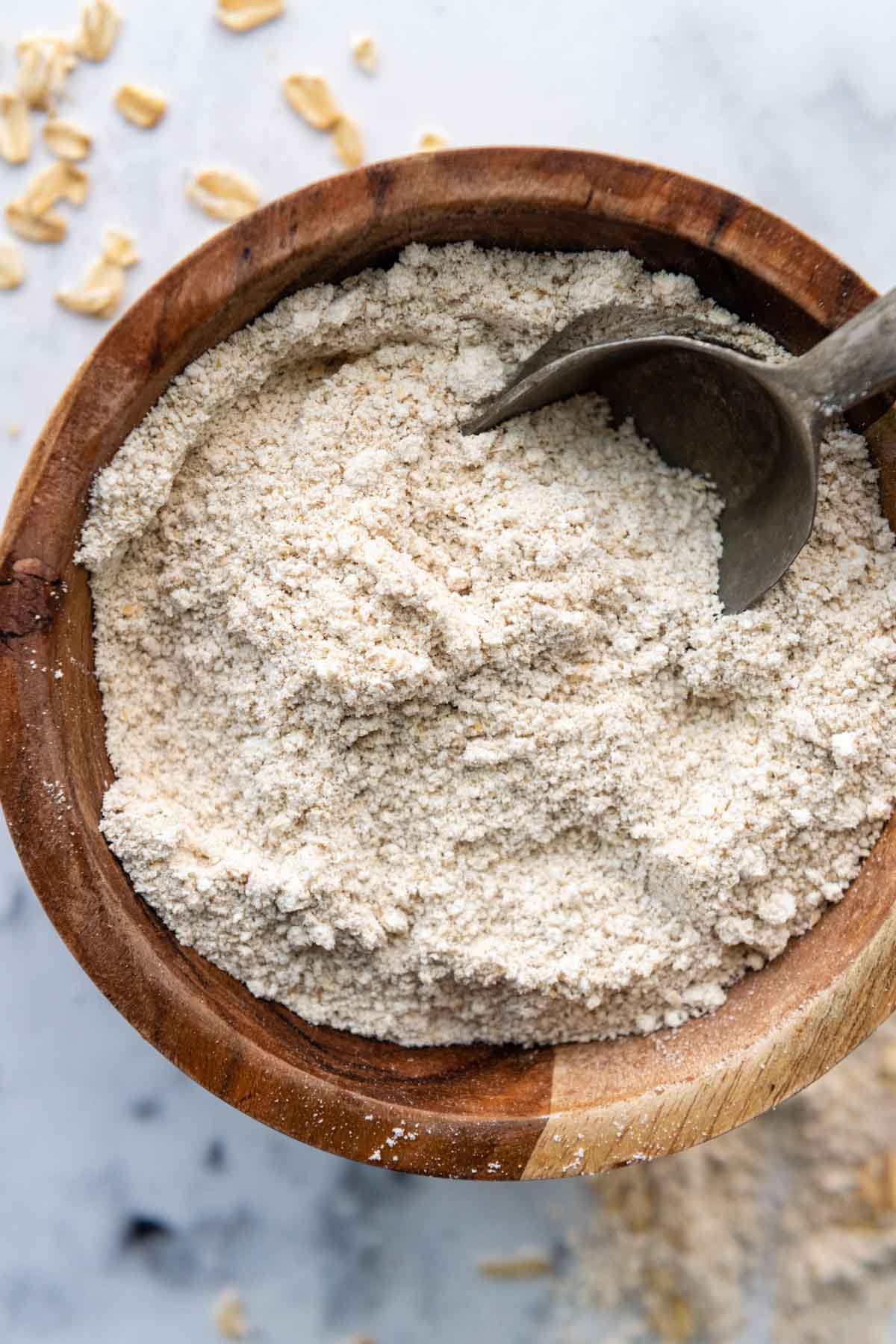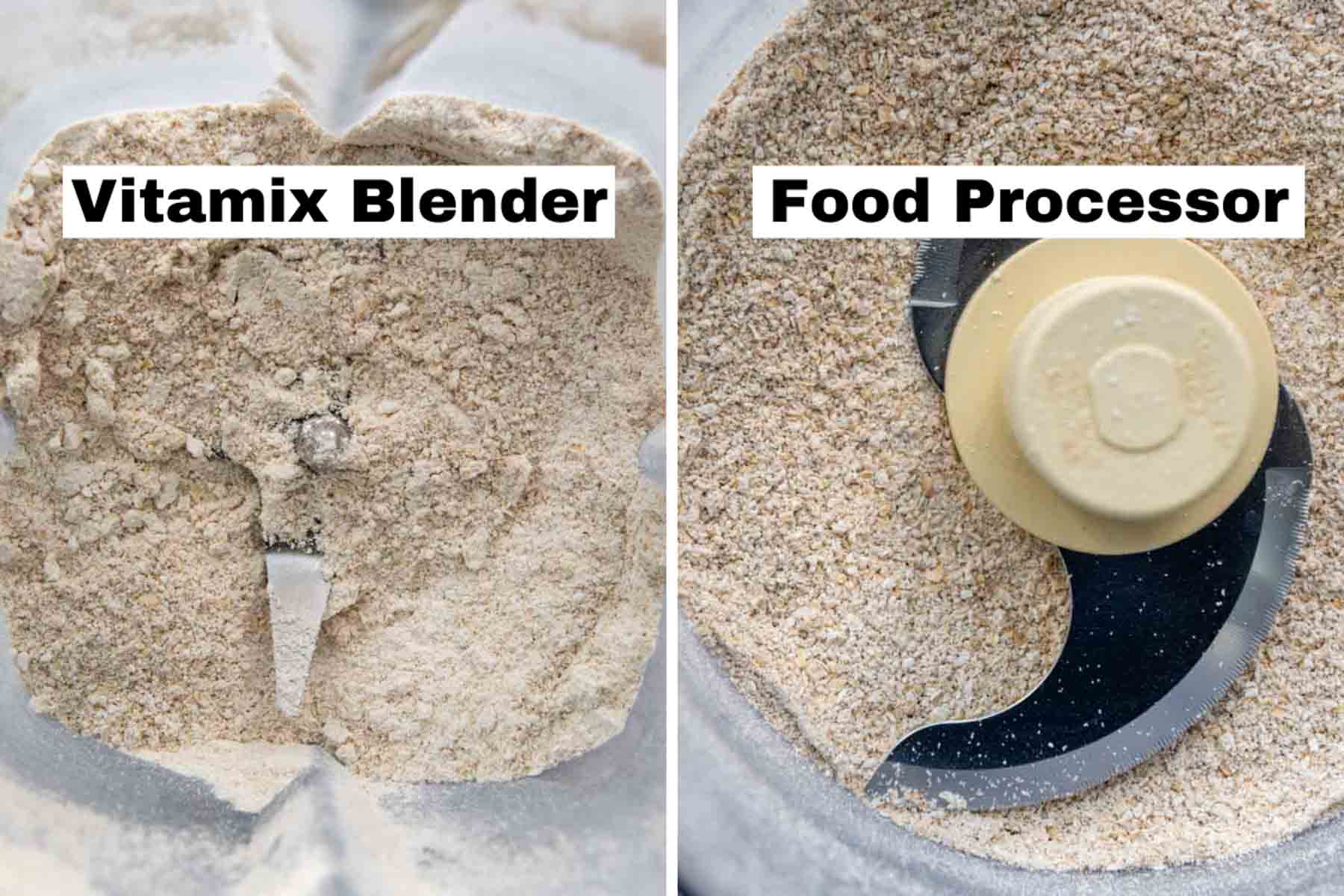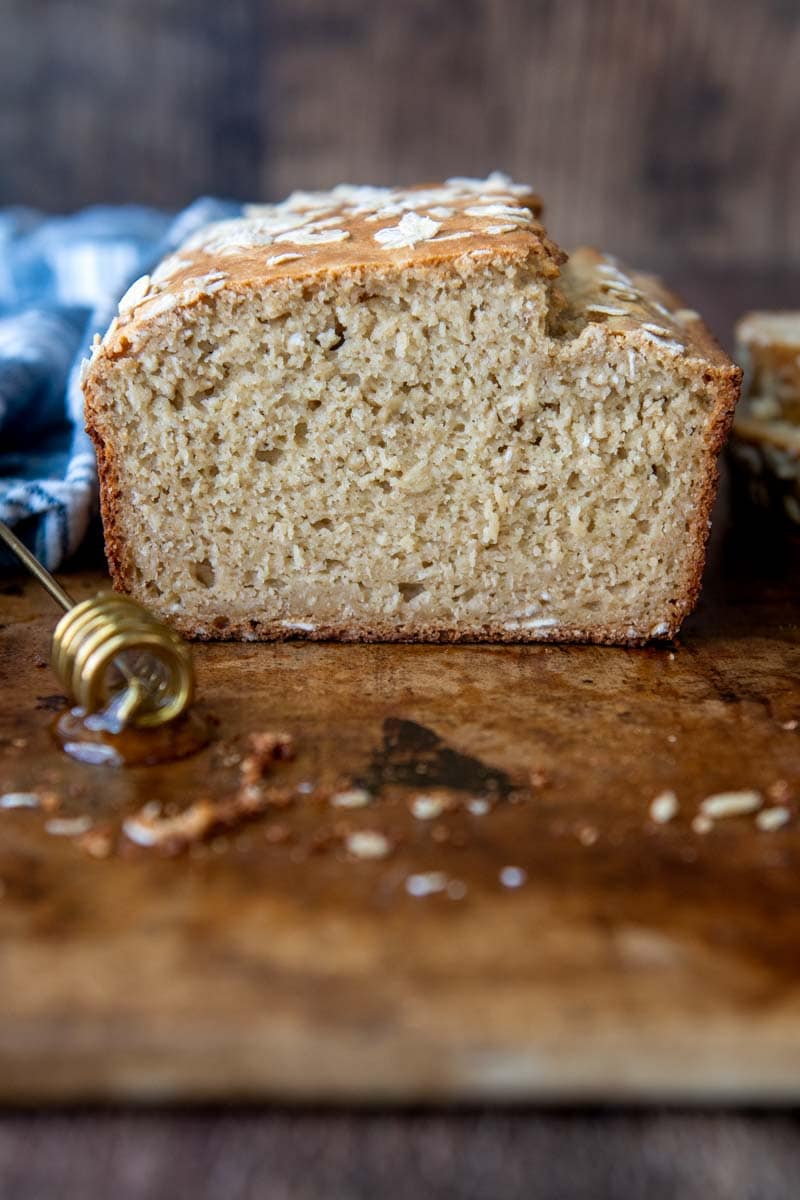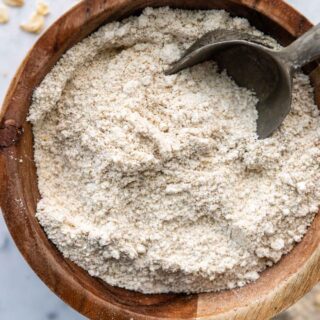Learn how to make oat flour with this easy tutorial! Here you will find a helpful oat flour resource, including expert tips to make the fluffiest oat flour, oatmeal to flour equivalents, oat flour substitutes, and so many more questions answered!

Not only does using oat flour in recipes make it a naturally gluten-free and healthy baking alternative, but it is much more cost-effective than all-purpose gluten-free flours, homemade almond flour, or other speciality grains.
Additionally, using oatmeal flour adds a slightly sweet, nutty flavor flavor to many gluten-free oat flour recipes, such as oat flour bread, cake, cookies, pie crusts, and oat flour muffins.
Discover everything you need to know to make oat flour at home, including how to store, substitute it for other flours, and how to achieve the fluffiest results!
Is Oat Flour Gluten-free?
Yes, technically it contains no wheat or gluten. However, it may become cross-contaminated during processing if it was manufactured on shared equipment. Furthermore, some people on a gluten-free diet, or with celiac disease, can not tolerate eating oats or oatmeal.
To make sure your homemade oatmeal flour is 100% gluten-free, be sure to use certified gluten-free oats or oatmeal. I can find Bob’s Red Mill gluten-free oatmeal at my local grocery store, but it can also be purchased at Trader Joe’s, Vitacost, or Amazon.
Is Oat Flour Ground oatmeal?
Yes. Oat flour is made from grinding oats in any form, from oat groats, steel cut oats, rolled oats, and quick oats. However, each type of oat used will yield a different amounts of oat flour. See the Oat Flour Equivalents section for more information on yields.
If you are not gluten intolerant, use any plain oatmeal and blend into a fine powder. To assure 100% oat flour without cross-contamination, be sure to use certified gluten-free oats.
Oatmeal can also be ground more coarse than a fluffy flour and used in recipes, such as oatmeal pie crust, energy protein balls, or in gluten-free apple crisp. If you only have a food processor, and not a high-powered blender, I suggest recipes such as these.
how to make Oat Flour In a Blender
The best way to make oat flour is to use a high-power blender, such as Vitamix or Blentec. As you can see from the image, the results are much more powdery, fluffy, and fine. This will yield better results in baked goods, such as oat flour cookies.
I have not tried processing oatmeal into flour using more affordable options, such as the Ninja or Magic Bullet blender. However, I know these options would work to make blender oat flour recipes, such as pumpkin oat flour muffins or flourless pancakes.
- Place the rolled oats or quick oats in the blender. Secure cover on.
- Blend the oats on medium speed until it turns into a fine, powdery flour, about 30 seconds – 1 minute. Check to be sure you don’t have any larger flecks of oats. If so, scrape down and blend again.

Using a food processor
I have found it’s hard to get great results to make oat flour in a food processor. This might work better with smaller capacity food processors, but my 14-cup Cuisinart did not yield great results.
A 10-cup food processor might work better because the blades would make more continuous contact with the oats. If you do make oat flour successfully with a smaller food processor, please leave me a comment below!
However, some recipes will work with a coarser oat flour because the batter rests and hydrates, like in oat flour waffles, or it cooks for an extended time, like oat flour banana bread, which also softens the crumb.
Click here to see the
step-by-step web story instructions for this recipe!
Oat flour equivalents
Many home bakers wonder how much one cup oats equals in oat flour. The question depends on what type of oats were used to make the flour. Grinding steel cut oats, rolled oats, or quick oats will all yield different flour amounts.
I’ve also found there is some variance between information published online and what I came up with on my own. I believe discrepancies occur based on what was used to grind the flour and the type of oatmeal used.
For instance, a Vitamix makes fluffy, light oat flour, while a food processor or coffee grinder would yield something more coarse and heavy (see image above).
Below are the median equivalents, but for best baking results weigh the flour rather than measuring it. These amounts were tested by making oat flour with a Vitamix blender:
- 1 cup steel cut oats = 1 ⅓ cup oat flour = 125 grams
- 1 cup whole rolled oats = 1 cup oat flour = 94 grams
- 1 cup quick oats = 1 cup + 1½ tablespoons oat flour = 98 grams
Storing Tips
Store homemade oat flour (or opened store bought) in airtight container up to 3 months. I particular love these OXO storage containers for a very secure seal. I use them for everything from homemade flour to granola.
For longer storage, place in a double layer of ziplock freezer bags, or airtight storage container, and freeze up to 6 months. Allow it to come to room temperature before using for baking.

Oat Flour Substitutes
Looking for an oat flour substitute for gluten-free baking? There are many replacements to choose from! However, these substitutes work best when converting recipes not made with 100% oat flour, but a smaller amount or mixture of starches.
Oat flour absorbs moisture more readily than other grains, so 100% oat flour recipes adjust the liquid ingredients accordingly. Some recipes, such as these gluten-free bagels or gluten-free granola bars, use a smaller amount of oat flour, making them good candidates for substitutions.
All of the substitutes can be used in a 1:1 ratio, with the exception of brown rice flour.
- Brown rice flour (Use 3/4 cup brown rice for every 1 cup oat flour)
- White rice flour
- Almond flour
- Coconut flour
- All purpose wheat flour
- Cassava flour
- Amaranth flour
- Buckwheat flour
Is Oat Flour Low Carb?
If you are on a Keto or low carb diet, oat flour is not your best choice. While it contains 68 grams carbohydrates, versus wheat flour’s 95g (in 1 cup), there are better options.
For instance, low carb baked goods may be made using oat fiber, which contains 0 carbs. Oat fiber is made from the husk grinding down the husk surrounding the oats, not the oatmeal itself.
SAVE THIS How to Make oat flour recipe for TO YOUR PINTEREST BOARD!
Let’s be friends on Pinterest! I’m always sharing great recipes!
Fluffy Oat Flour: How To Make, Substitutes, Equivalents
Equipment Needed
Ingredients
- 1 cup whole rolled oats (for gluten free oat flour, use certified GF oats)
Instructions
- Place the oatmeal in a high-powered blender. Blend the oats until it turns into a fine, powdery flour, about 30 seconds – 1 minute.
- Check to see if there are any large flecks, if so scrape the sides and process again.
- 1 cup whole rolled oats = 1 cup oat flour, 94 grams; 1 cup quick oats = 1 cup 1½ tablespoons oat flour, 98 grams (if using Vitamix)
- DID YOU MAKE THIS RECIPE?? DON'T FORGET TO LEAVE FEEDBACK AND/OR CLICK A STAR RATING ON THE RECIPE CARD!
Recipe Notes
Storing Tips
Store homemade oat flour (or opened store bought) in airtight container up to 3 months. For longer storage, place in a double layer of ziplock freezer bags, or airtight storage container, and freeze up to 6 months. Allow it to come to room temperature before using for baking.Nutrition
This post contains affiliate links. My opinions are always my own. If you purchase a product through an affiliate link, I make a small commission – at no cost to you. Read full disclosure policy here.


Leave a Reply